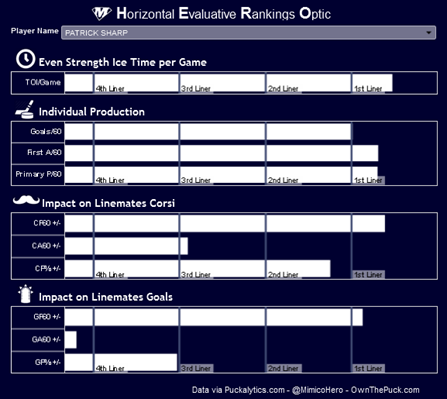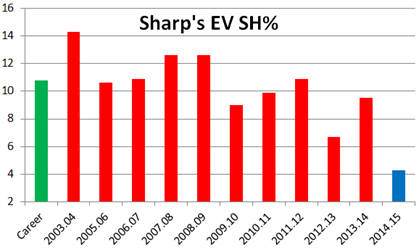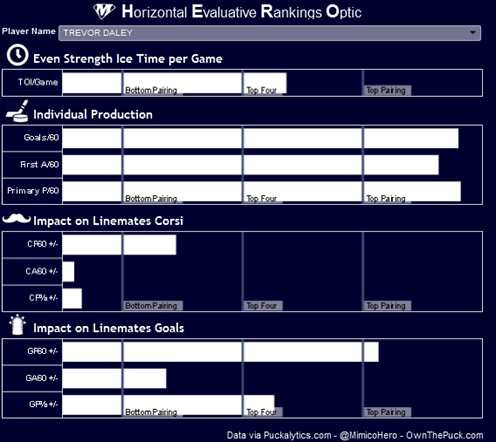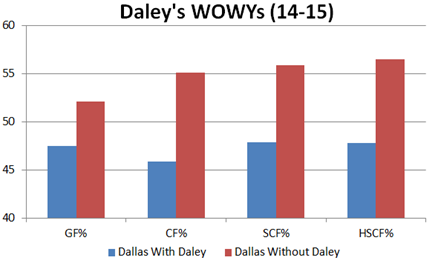
A few weeks ago, the Dallas Stars acquired star forward Patrick Sharp from the Chicago Blackhawks along with defensive prospect Stephen Johns in exchange for defenseman Trevor Daley and forward Ryan Garbutt. Sharp was the latest salary cap casualty for the Stanley Cup Champion Chicago Blackhawks after parting ways with restricted free agent (RFA) forward Brandon Saad earlier this offseason. In this deal, Dallas acquires a talented winger that has reached the 30 goal plateau four times in his career. In Daley, the Chicago Blackhawks acquire an average defenseman known for his offensive abilities.
Both Sharp and Daley had a disappointing season last year as Sharp’s production was down and Daley was a liability in his defensive zone. Both players should benefit from a new setting and we should see them rebound with their new team.
Patrick Sharp – Dallas Stars
Sharp had a down season production-wise in 2014-2015 that saw the former four-time 30 goal scorer and five-time 60 point producer score only 16 goals and 44 points in 68 games. Sharp missed about a dozen games due to injury and was relegated down to the third line alongside Andrew Shaw and Bryan Bickell for a good part of the season. He saw his ice time on the power play slip over 24 seconds per game from the previous season. Sharp’s decline could be alarming as he’s 33 years old and could never regain his scoring knack but advanced statistics show that he is doing all the right things and can bounce back this season.
Looking at Sharp’s HERO Chart, it is clear to see he’s been a top line player over the past three seasons. His production in the offensive zone is very high, but hasn’t been great in the defensive zone as his Corsi Against Per 60 Minutes of Ice Time (CA/60) and his Goals Against Per 60 Minutes of Ice Time (GA/60) are very low compared to his ice time.
Looking at the Chicago’s Corsi (measure of shot attempts for vs. against) with and without Sharp on the ice based on a moving 40 game average, his positive impact has been very obvious. Sharp has averaged a 56.2% CF% over the past six seasons while Chicago has averaged a 53.0% CF% without Sharp on the ice (3.2% CF%Rel). Over this same stretch, Sharp has controlled 55.1% of all scoring chances (SCF%) (2.3% SCF%Rel compared to Chicago without Sharp) and 53.4% of all high-danger scoring chances (HSCF%) (2.0% HSCF%Rel compared to Chicago without Sharp). Chicago is a good team without Sharp but with him, they are an elite team. There were many stretches where Chicago was much better with Sharp on the ice than without him on the ice as shown in the above graph.
Looking at Sharp’s even strength shooting percentage over his 11 season NHL career (not including 02-03 when he only played three games and didn’t register a point), last season was a huge outlier. His 4.3% SH% is by far the lowest of his career (in the 2012-2013 lockout shortened season, Sharp’s season was cut even shorter due to injury. He skated in 28 regular season games and registered his second lowest SH% of 6.7%) and well below his career average of 10.8%. For top snipers, shooting percentage is sustainable even as they age and production declines. Other stars such as Jaromir Jagr, Martin St. Louis, Jarome Iginla, Henrik Sedin, and Thomas Vanek are examples that this holds true. Expect his shooting percentage to jump up to over 9% this coming season.
One may claim that Sharp’s numbers were down this year because he wasn’t shooting the puck enough but that doesn’t seem to be true. Sharp is still individually driving the play as Travis Yost mentioned. His 10.99 shots/60 ranked 5th in the league last year and his 18.70 iCorsi/60 ranked 13th in the league. Those numbers are very consistent with his five year average of 10.82 shots/60 (ranked 13th in the league over that span) and 18.46 iCorsi/60 (ranked 14th in the league over the same span). The shot attempts are there for Sharp, he just needs to find a way to better capitalize on his opportunities.
Sharp’s demotion to the third line hurt his production totals this season, but in Dallas, he’ll have the chance to play a major role on one of the team’s top two lines. Dallas is deep down the middle with Tyler Seguin and Jason Spezza leading the depth chart. Sharp is more likely to play with Spezza as Jamie Benn played on Seguin’s left wing this season and almost won the scoring title. It is very hard to see head coach Lindy Ruff splitting up those two. Sharp should see an increase in minutes this season compared to last year as he’s be playing in a more prominent scoring role and will be counted on to help the team reach the playoffs.
Potentially on a line with Spezza, Sharp gets a very talented center capable of setting up goals. Spezza’s 1.39 A/60 ranks 13th in the league over the past five seasons (of eligible players with a minimum of 3,000 TOI) and his .96 FirstA/60 ranks 7th in the league in that same timespan. Spezza’s most consistent winter during the middle 2000’s was Dany Heatley who scored 39 or more goals four times alongside him while playing for Ottawa. Spezza may be older now (32 years old) but is very capable of helping Sharp score 30+ goals this season.
Trevor Daley – Chicago Blackhawks
There is no way to sugar coat it. Trevor Daley had an awful season in 2014-2015. On the league’s second highest scoring team (1 goal behind Tampa Bay for league lead), he put up career highs in goals (16 – 5th in the league among defensemen), assists (22), and points (38) but was a liability in his defensive end. Daley was often trapped in his defensive end and gave up a majority of the shot attempts.
Looking at Daley’s HERO Chart, the first thing you notice is that his individual production metrics are off the chart. Then look a little further down the chart and you notice his impact on his linemates Corsi is off the charts in the opposite direction. His CA/60 and CF% metrics are well below that of a bottom pairing defenseman. Even his GA/60 metric is that of a bottom pairing defenseman. While scoring points is nice bonus, a defenseman’s main objective is limiting the other team’s shot attempts and stopping them from scoring. It is very obvious that Daley struggled to do just that. One could argue his offensive production value is the main thing keeping him in the league after this past season.
Looking at Daley’s WOWY’s on the team level, it is clear that he was a liability whenever he was on the ice. Daley had negative Goals, Corsi, Scoring Chances, and High Danger Scoring Chances For Percentages this past season. With Daley on the ice, Dallas played at the level of a bottom-five team, but without Daley, Dallas played at the level of a very good team for their Goals For percentage (52.1% GF%) and as an elite team for their shot differential metrics (55.1% CF%, 55.9% SCF%, and 56.5% HSCF%). The team was simply better without him.
Daley’s play was one of the main reasons why Dallas didn’t qualify for the playoffs. It wouldn’t be as big of a deal if Daley got bottom pairing minutes and was sheltered from the opponent’s top players, but that wasn’t the case at all. Daley finished the season with almost 1100 even strength minutes and averaged the 3rd most even strength time on ice per game among Dallas defensemen (16+ TOI/gm). On the team’s second pairing, he was often sent out against the opponents top players.
Daley also wasn’t surrounded by defensemen that could carry him. His most consistent pairing was with Alex Goligoski who is a talented defensemen with strong career possession numbers. Pairing Daley with Goligoski hurt the team as the team’s top defenseman was hindered by Daley’s weak play (47.3% CF% with Daley, 55.5% CF% without Daley). Besides Goligoski, Daley’s remaining even strength minutes were split between Jyrki Jokipakka, Jason Demers, Jamie Oleksiak, and Jordie Benn; none of which could carry the majority of shot attempts alongside Daley. He wasn’t able to develop strong chemistry with anyone in the system.
A trade to Chicago may be just what Daley needed to move past this horrendous year. Daley rounds out Chicago’s top four defensemen that also includes Ducan Keith, Brent Seabrook, and Niklas Hjalmarsson. After losing Johnny Oduya to Dallas via free agency, Chicago’s management isn’t confident that Michal Rozsival, David Rundblad or Trevor Van Riemsdyk are ready to take the next step in their career playing big minutes against top competition. With Keith and Seabrook putting up impressive numbers together (54.2% GF%, 55.2% CF% in almost 700 even strength minutes together last season), Daley’s most likely partner is Hjalmarsson.
Over the past four seasons, Hjalmarsson’s most consistent defensive partner has been the recently departed Oduya (2500+ even strength minutes together). Oduya was a below average defensemen away from Hjalmarsson, but helped make up a very strong second defensive pairing with him. Both his GF% and CF% saw a considerable bump playing with Hjalmarsson. This is a testament that Hjalmarsson’s strong play can raise that the level of his partner’s play. Pairing Daley with Hjalmarsson could be very effective if they can develop similar chemistry. If so, expect Daley’s possession numbers to rise while he continues to produce offensively.
If Daley still struggles alongside Hjalmarsson, look for Chicago to slide Rozsival up to the second pairing and shelter Daley on the third pairing. It would be hard for Chicago’s top four defensemen to play 90% of all even-strength minutes over the entire season like they did during the 2015 postseason, but it may be necessary down the stretch if they can’t trust Daley.
Follow Steve Ness on Twitter at: @QuickkNess
All data from War-On-Ice.com, Puckalytics, Stats.hockeyanalytics.com, OwnThePuck, & NHL.com.







This is a great article. Lots of Chicago media and fans had a similar reaction to Oduya when he came over from Winny/Atlanta. It would be interesting to see Oduya’s stats in the year or two prior to joining the Hawks, vs his stats with the Hawks, specifically Hammer.
LikeLike
Quick look at Oduya’s stint with ATL/WPG – 171 games, 48.97% GF% (-4.83% GF%Rel), 46.49% CF% (-3.56% CF%Rel), 45.81% SCF% (-3.58% SCF%Rel), 43.6% HSCF% (-5% HSCF%Rel). Not good numbers at all..
Oduya with CHI: 219 games, 54.14% GF% (-2.19% GF%Rel), 52.64% CF% (-2.73% CF%Rel), 52.49% SCF% (-2.7% SCF%Rel), 51.27% HSCF% (-3.1% HSCF%Rel)
Oduya with Hjalmarsson in CHI: 56% GF%, 53.2% CF%
Oduya without Hjalmarsson in CHI: 50% GF%, 51.9% CF%
Hjalmarsson without Oduya in CHI: 59.4% GF%, 53.8% CF%
Hjalmarsson clearly carried Oduya in Chicago..
LikeLike